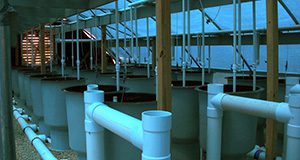This 6-page fact sheet written by Emily H. Roan, Laura Tiu, Roy P.E. Yanong, Matthew A. DiMaggio, and Joshua T. Patterson and published by the UF/IFAS Program in Fisheries and Aquatic Sciences, School of Forest Resources and Conservation provides introductory information for people interested in engaging in commercial or hobby-scale aquaculture in urban or suburban areas. It introduces three common types of urban aquaculture systems, describes the resources and challenges unique to urban aquaculture, and includes a handy “getting started” section.
http://edis.ifas.ufl.edu/fa217
Tag: Roy P.E. Yanong
Cryptobia iubilans in Cichlids
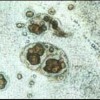 After many years of diagnostics at the University of Florida and at other laboratories around the country, it appears that Cryptobia iubilans is not uncommon among cichlids, and that environmental and other factors determine the extent of disease.This 3-page fact sheet was written by Ruth Francis-Floyd and Roy Yanong, and published by the UF Department of Fisheries and Aquatic Sciences, September 2014.
After many years of diagnostics at the University of Florida and at other laboratories around the country, it appears that Cryptobia iubilans is not uncommon among cichlids, and that environmental and other factors determine the extent of disease.This 3-page fact sheet was written by Ruth Francis-Floyd and Roy Yanong, and published by the UF Department of Fisheries and Aquatic Sciences, September 2014.
http://edis.ifas.ufl.edu/vm077
Koi Herpesvirus Disease (KHVD) (VM149/VM113)
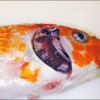 Koi herpesvirus (KHV) is a highly contagious virus that causes significant morbidity and mortality in common carp varieties. Common carp is raised as a foodfish in many countries and has also been selectively bred for the ornamental fish industry where it is known as koi. The first recognized case of KHV occurred in the United Kingdom in 1996. Since then other cases have been confirmed in almost all countries that culture koi and/or common carp with the exception of Australia. This 9-page fact sheet is intended to inform veterinarians, biologists, fish producers and hobbyists about KHV disease. Written by Kathleen H. Hartman, Roy P.E. Yanong, Deborah B. Pouder, B. Denise Petty, Ruth Francis-Floyd, Allen C. Riggs, and Thomas B. Waltzek, and published by the UF Department of Fisheries and Aquatic Sciences, April 2013.
Koi herpesvirus (KHV) is a highly contagious virus that causes significant morbidity and mortality in common carp varieties. Common carp is raised as a foodfish in many countries and has also been selectively bred for the ornamental fish industry where it is known as koi. The first recognized case of KHV occurred in the United Kingdom in 1996. Since then other cases have been confirmed in almost all countries that culture koi and/or common carp with the exception of Australia. This 9-page fact sheet is intended to inform veterinarians, biologists, fish producers and hobbyists about KHV disease. Written by Kathleen H. Hartman, Roy P.E. Yanong, Deborah B. Pouder, B. Denise Petty, Ruth Francis-Floyd, Allen C. Riggs, and Thomas B. Waltzek, and published by the UF Department of Fisheries and Aquatic Sciences, April 2013.
http://edis.ifas.ufl.edu/vm113
Lernaea (Anchorworm) Infestations in Fish (FA185)
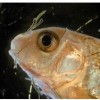 Lernaea species, commonly known as “anchorworms,” are crustacean, copepod parasites that can infect and cause disease and mortality in many types of freshwater fishes, especially wild-caught and pond-raised species. Infestations with Lernaea are most prevalent in the summer months and occur more commonly in stagnant or slow-moving water bodies. This 4-page fact sheet was written by Natalie Steckler and Roy P. E. Yanong, and published by the UF Department of Fisheries and Aquatic Sciences, December 2012.
Lernaea species, commonly known as “anchorworms,” are crustacean, copepod parasites that can infect and cause disease and mortality in many types of freshwater fishes, especially wild-caught and pond-raised species. Infestations with Lernaea are most prevalent in the summer months and occur more commonly in stagnant or slow-moving water bodies. This 4-page fact sheet was written by Natalie Steckler and Roy P. E. Yanong, and published by the UF Department of Fisheries and Aquatic Sciences, December 2012.
http://edis.ifas.ufl.edu/fa185
Argulus (Fish Louse) Infections in Fish (FA184)
 Argulus species (Family: Argulidae), more commonly known as fish lice, are members of a large group of branchiuran parasites that infest and cause disease in fish. The argulids are crustaceans and are related to crabs, lobsters, and shrimp. This 5-page fact sheet was written by Natalie Steckler and Roy P. E. Yanong, and published by the UF Department of Fisheries and Aquatic Sciences, November 2013.
Argulus species (Family: Argulidae), more commonly known as fish lice, are members of a large group of branchiuran parasites that infest and cause disease in fish. The argulids are crustaceans and are related to crabs, lobsters, and shrimp. This 5-page fact sheet was written by Natalie Steckler and Roy P. E. Yanong, and published by the UF Department of Fisheries and Aquatic Sciences, November 2013.
http://edis.ifas.ufl.edu/fa184
Spring Viremia of Carp (VM142/VM106)
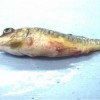 Spring viremia of carp is a viral disease that can cause significant mortality in several carp species including the common carp. It was reported in koi and feral carp in the United States for the first time in 2002. Diagnosis in farm raised fish in the U.S. may result in quarantine of the infected fish and depopulation. This 5-page fact sheet is intended to inform veterinarians, biologists, culturists, and hobbyists about Spring viremia of carp. Written by Barbara D. Petty, Ruth Francis-Floyd, and Roy P.E. Yanong, and published by the UF Department of Fisheries and Aquatic Sciences, August 2012.
Spring viremia of carp is a viral disease that can cause significant mortality in several carp species including the common carp. It was reported in koi and feral carp in the United States for the first time in 2002. Diagnosis in farm raised fish in the U.S. may result in quarantine of the infected fish and depopulation. This 5-page fact sheet is intended to inform veterinarians, biologists, culturists, and hobbyists about Spring viremia of carp. Written by Barbara D. Petty, Ruth Francis-Floyd, and Roy P.E. Yanong, and published by the UF Department of Fisheries and Aquatic Sciences, August 2012.
http://edis.ifas.ufl.edu/vm106
Megalocytivirus Infections in Fish, with Emphasis on Ornamental Species (FA182)
Megalocytiviruses cause systemic infections that can result in moderate to heavy losses in many different species of freshwater and marine fishes in both cultured and wild stocks. This 8-page fact sheet was written by Roy P. E. Yanong and Thomas B. Waltzek, and published by the UF Department of Fisheries and Aquatic Sciences, December 2010.
http://edis.ifas.ufl.edu/fa182
Lymphocystis Disease in Fish (FA181/FA181)
Lymphocystis is a chronic disease of freshwater and marine fishes caused by infection with an iridovirus known as Lymphocystivirus or Lymphocystis disease virus (LCDV). Infection results in the development of pebble or wart-like nodules most commonly seen on the fins, skin, or gills, although other tissues may be affected. This 5-page fact sheet was written by Roy P. E. Yanong, and published by the UF Department of Fisheries and Aquatic Sciences, December 2010.
http://edis.ifas.ufl.edu/fa181
Viral Nervous Necrosis (Betanodavirus) Infections in Fish (FA180/FA180)
The betanodaviruses are an important, emerging group of viruses known to infect over 40 marine fish species worldwide. This 7-page fact sheet was written by Roy P. E. Yanong, and published by the UF Department of Fisheries and Aquatic Sciences, December 2010.
http://edis.ifas.ufl.edu/fa180
FA165 Use of Copper in Marine Aquaculture and Aquarium Systems
FA165, a 6-page fact sheet by Roy P. E. Yanong, discusses the use of “bluestone” or “blue copperas” copper sulfate — basic copper chemistry, chelated copper, toxicity to target and non-target organisms, determining dose, reaching and maintaining desired concentrations, and removing copper from the system. Includes references. Published by the UF Program in Fisheries and Aquatic Sciences, School of Forest Resources and Conservation, December 2009.
http://edis.ifas.ufl.edu/fa165
FA161 Use of Ovaprim in Ornamental Fish Aquaculture
FA161, an 8-page illustrated fact sheet by Roy P. E. Yanong, Carlos Martinez, and Craig A. Watson, explains for ornamental fish producers the mode of action and considerations for the use of ovaprim, a hormone product used as a spawning aid. Includes references. Published by the UF Program in Fisheries and Aquatic Sciences, School of Forest Resources and Conservation, December 2009.
http://edis.ifas.ufl.edu/fa161
FA164 Cryptocaryon irritans Infections (Marine White Spot Disease) in Fish
FA164, a 10-page illustrated fact sheet by Roy P. E. Yanong, describes this significant disease problem for marine aquarists and commercial mariculture worldwide — signs of disease, biology and life cycle, immunity, diagnostics, prevention and control, disinfection, and biosecurity considerations. Includes references. Published by the UF Program in Fisheries and Aquatic Sciences, December 2009.
http://edis.ifas.ufl.edu/fa164
FA157 Use of Hydrogen Peroxide in Finfish Aquaculture
FA157, a 6-page fact sheet by Roy P. E. Yanong, uses a question-and-answer format to discuss how to use the hydrogen-peroxide based product 35% PEROX-AID ® as aquaculture treatment. Includes references. Published by the UF Program in Fisheries and Aquatic Sciences in the School of Forest Resources and Conservation, December 2008.
http://edis.ifas.ufl.edu/FA157
FA156 Use of Vaccines in Finfish Aquaculture
FA156, an 8-page fact sheet by Roy P. E. Yanong, uses a question-and-answer format to address the topic of vaccine use in warmwater aquaculture facilities. Includes references. Published by the UF Program in Fisheries and Aquatic Sciences, School of Forest Resources and Conservation, December 2008.
http://edis.ifas.ufl.edu/FA156
VM-149/VM113 Koi Herpesvirus (KHV) Disease
Revised! VM-149, a 9-page illustrated fact sheet by Kathleen H. Hartman, Roy P.E. Yanong, Deborah B. Pouder, B. Denise Petty, Ruth Francis-Floyd and Allen C. Riggs, informs veterinarians, biologists, fish producers and hobbyists about the KHV disease in a question-and-answer format. Includes glossary and references. Published by the UF College of Veterinary Medicine, October 2008.
http://edis.ifas.ufl.edu/VM113
